\( \DeclareMathOperator{\abs}{abs} \newcommand{\ensuremath}[1]{\mbox{$#1$}} \)
Differential Geometry with GNU/Linux: The Monkey Saddle Surface with Embedded Parabolic Curve
1 Introductory Spiel
2 The Monkey Saddle and Curves Thereon
| (%i1) | kill(all)$ |
| (%i4) | load(vect)$ load(draw)$ load(eigen)$ load(ctensor)$ |
| (%i5) | set_draw_defaults(head_angle=10, head_length=0.03, proportional_axes=xyz, nticks=800, xyplane=0, surface_hide=true, line_width=2, view=[62, 140])$ |
2.1 Define the surface, the monkey saddle
\[ f(u, v) = [x, y, z] = [u, v, u^3-3 u v^2] \]
In these Maxima demos, we will always use \(\mathbf f\) as our surface mapping and \(\mathbf c\) as our curve function, with derivatives indicated by a following letter:
\[ \frac{\partial \mathbf{f}}{\partial u} \to fu\]
\[ \frac{\mathrm{d}\mathbf{c}}{\mathrm{d}t} \to ct \]
| (%i8) |
f: [u,v,u^3-3*u*v^2]; fu:diff(f,u); fv:diff(f,v); |
\[ \mathbf{f} = \left[ u\mathop{,}v\mathop{,}{{u}^{3}}\mathop{-}3 u {{v}^{2}}\right] \]
\[ \mathbf{fu} = \left[ 1\mathop{,}0\mathop{,}3 {{u}^{2}}\mathop{-}3 {{v}^{2}}\right] \]
\[ \mathbf{fv} = \left[ 0\mathop{,}1\mathop{,}\mathop{-}\left( 6 u v\right) \right] \]
| (%i9) | ratsimp(express(fu~fv)); |
\[ \left[ 3 {{v}^{2}}\mathop{-}3 {{u}^{2}}\mathop{,}6 u v\mathop{,}1\right] \]
2.2 Define a curve on the surface parameterized with t
| (%i15) |
/* define u,t in terms of t for later use */ tu:t$ tv:t^2$ c:ev(f, u=tu, v=tv); ct:diff(c,t); ctt:diff(c,t,2); cttt:diff(c,t,3); |
\[ \mathbf{c} = \left[ t\mathop{,}{{t}^{2}}\mathop{,}{{t}^{3}}\mathop{-}3 {{t}^{5}}\right] \]
\[ \mathbf{ct} = \left[ 1\mathop{,}2 t\mathop{,}3 {{t}^{2}}\mathop{-}15 {{t}^{4}}\right] \]
\[ \mathbf{ctt} = \left[ 0\mathop{,}2\mathop{,}6 t\mathop{-}60 {{t}^{3}}\right] \]
\[ \mathbf{cttt} = \left[ 0\mathop{,}0\mathop{,}6\mathop{-}180 {{t}^{2}}\right] \]
| (%i16) | vel:ratsimp(sqrt(ct.ct)); |
\[ \sqrt{225 {{t}^{8}}\mathop{-}90 {{t}^{6}}\mathop{+}9 {{t}^{4}}\mathop{+}4 {{t}^{2}}\mathop{+}1}\]
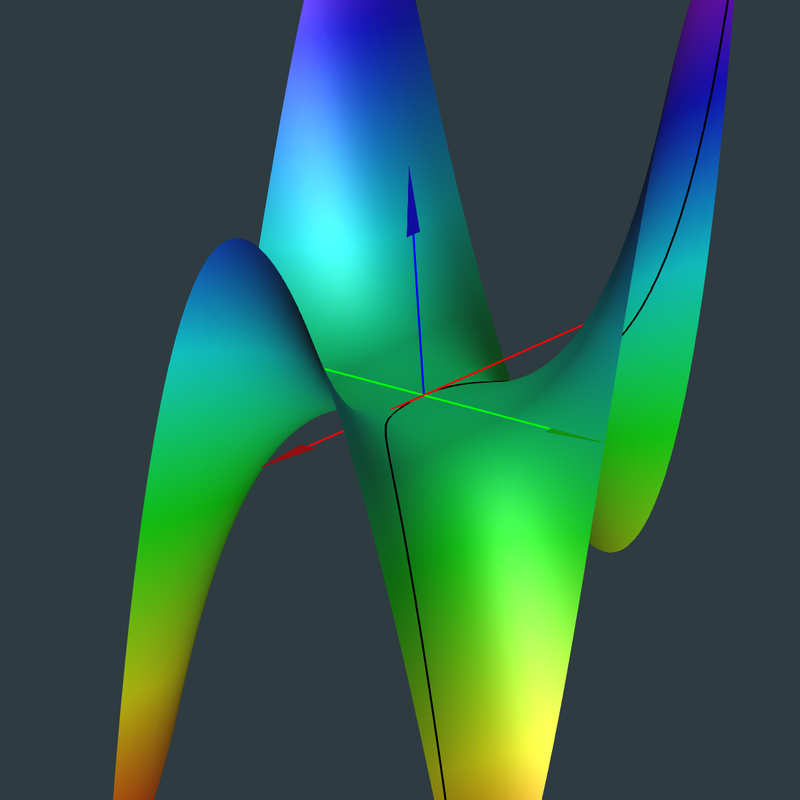
Click Image for Narrated Video
Link for StageTools Script
2.3 Curvature parameters of the curve on the surface
| (%i19) | integrate(sqrt(ct.ct),t); |
\[ \int \sqrt{{{\left( 3 {{t}^{2}}\mathop{-}15 {{t}^{4}}\right) }^{2}}\mathop{+}4 {{t}^{2}}\mathop{+}1}{\, dt}\]
2.3.1 The Darboux moving frame, the unit tangent, T, and unit normal, N, vectors.
Because the Darboux frame is essentially a rotated version of the Frenet-Serret frame, we need to determine also the Frenet unit vectors.
| (%i20) | T:(fullratsimp(ct/sqrt(ct.ct))); |
\[ \mathbf{T} = \left[ \frac{1}{\sqrt{225 {{t}^{8}}\mathop{-}90 {{t}^{6}}\mathop{+}9 {{t}^{4}}\mathop{+}4 {{t}^{2}}\mathop{+}1}}\mathop{,}\frac{2 t}{\sqrt{225 {{t}^{8}}\mathop{-}90 {{t}^{6}}\mathop{+}9 {{t}^{4}}\mathop{+}4 {{t}^{2}}\mathop{+}1}}\mathop{,}\mathop{-}\left( \frac{15 {{t}^{4}}\mathop{-}3 {{t}^{2}}}{\sqrt{225 {{t}^{8}}\mathop{-}90 {{t}^{6}}\mathop{+}9 {{t}^{4}}\mathop{+}4 {{t}^{2}}\mathop{+}1}}\right) \right] \]
| (%i21) | ratsimp(T.T); |
\[ 1\]
| (%i23) |
/* define tmp1 = ct x ctt for later use*/ tmp1:fullratsimp(express(ct~ctt))$ B:fullratsimp(tmp1/sqrt(tmp1.tmp1)); |
\[ \mathbf{B} = \left[ \mathop{-}\left( \frac{90 {{t}^{4}}\mathop{-}6 {{t}^{2}}}{\sqrt{8100 {{t}^{8}}\mathop{+}2520 {{t}^{6}}\mathop{-}684 {{t}^{4}}\mathop{+}36 {{t}^{2}}\mathop{+}4}}\right) \mathop{,}\frac{60 {{t}^{3}}\mathop{-}6 t}{\sqrt{8100 {{t}^{8}}\mathop{+}2520 {{t}^{6}}\mathop{-}684 {{t}^{4}}\mathop{+}36 {{t}^{2}}\mathop{+}4}}\mathop{,}\frac{2}{\sqrt{8100 {{t}^{8}}\mathop{+}2520 {{t}^{6}}\mathop{-}684 {{t}^{4}}\mathop{+}36 {{t}^{2}}\mathop{+}4}}\right] \]
| (%i24) | ratsimp(B.B); |
\[ 1\]
| (%i25) | ratsimp(B.T); |
\[ 0\]
| (%i26) | N:ratsimp(factor(express(B~T))); |
\[ \mathbf{N} = \left[ \mathop{-}\left( \frac{450 {{t}^{7}}\mathop{-}135 {{t}^{5}}\mathop{+}9 {{t}^{3}}\mathop{+}2 t}{\sqrt{225 {{t}^{8}}\mathop{-}90 {{t}^{6}}\mathop{+}9 {{t}^{4}}\mathop{+}4 {{t}^{2}}\mathop{+}1} \sqrt{2025 {{t}^{8}}\mathop{+}630 {{t}^{6}}\mathop{-}171 {{t}^{4}}\mathop{+}9 {{t}^{2}}\mathop{+}1}}\right) \mathop{,}\mathop{-}\left( \frac{675 {{t}^{8}}\mathop{-}180 {{t}^{6}}\mathop{+}9 {{t}^{4}}\mathop{-}1}{\sqrt{225 {{t}^{8}}\mathop{-}90 {{t}^{6}}\mathop{+}9 {{t}^{4}}\mathop{+}4 {{t}^{2}}\mathop{+}1} \sqrt{2025 {{t}^{8}}\mathop{+}630 {{t}^{6}}\mathop{-}171 {{t}^{4}}\mathop{+}9 {{t}^{2}}\mathop{+}1}}\right) \mathop{,}\mathop{-}\left( \frac{90 {{t}^{5}}\mathop{+}24 {{t}^{3}}\mathop{-}3 t}{\sqrt{225 {{t}^{8}}\mathop{-}90 {{t}^{6}}\mathop{+}9 {{t}^{4}}\mathop{+}4 {{t}^{2}}\mathop{+}1} \sqrt{2025 {{t}^{8}}\mathop{+}630 {{t}^{6}}\mathop{-}171 {{t}^{4}}\mathop{+}9 {{t}^{2}}\mathop{+}1}}\right) \right] \]
| (%i29) |
ratsimp(N.N); ratsimp(N.T); ratsimp(N.B); |
\[ 1\]
\[ 0\]
\[ 0\]
| (%i34) |
/* the unit surface normal, \( n \) and its expression, \( nt \), along the curve */ n:express(fu~fv)$ n:fullratsimp(n/sqrt(n.n)); nt:ev(n, u=tu, v=tv); /* check */ ratsimp(n.n); ratsimp(nt.nt); |
\[ \mathbf{n} = \left[ \frac{3 {{v}^{2}}\mathop{-}3 {{u}^{2}}}{\sqrt{9 {{v}^{4}}\mathop{+}18 {{u}^{2}} {{v}^{2}}\mathop{+}9 {{u}^{4}}\mathop{+}1}}\mathop{,}\frac{6 u v}{\sqrt{9 {{v}^{4}}\mathop{+}18 {{u}^{2}} {{v}^{2}}\mathop{+}9 {{u}^{4}}\mathop{+}1}}\mathop{,}\frac{1}{\sqrt{9 {{v}^{4}}\mathop{+}18 {{u}^{2}} {{v}^{2}}\mathop{+}9 {{u}^{4}}\mathop{+}1}}\right] \]
\[ \mathbf{nt} = \left[ \frac{3 {{t}^{4}}\mathop{-}3 {{t}^{2}}}{\sqrt{9 {{t}^{8}}\mathop{+}18 {{t}^{6}}\mathop{+}9 {{t}^{4}}\mathop{+}1}}\mathop{,}\frac{6 {{t}^{3}}}{\sqrt{9 {{t}^{8}}\mathop{+}18 {{t}^{6}}\mathop{+}9 {{t}^{4}}\mathop{+}1}}\mathop{,}\frac{1}{\sqrt{9 {{t}^{8}}\mathop{+}18 {{t}^{6}}\mathop{+}9 {{t}^{4}}\mathop{+}1}}\right] \]
\[ 1 \]
\[ 1 \]
| (%i36) |
U:ratsimp(factor(express(nt~T))); ratsimp(U.U); |
\[ \mathbf{U} = \left[ \mathop{-}\left( \frac{90 {{t}^{7}}\mathop{-}18 {{t}^{5}}\mathop{+}2 t}{\sqrt{9 {{t}^{8}}\mathop{+}18 {{t}^{6}}\mathop{+}9 {{t}^{4}}\mathop{+}1} \sqrt{225 {{t}^{8}}\mathop{-}90 {{t}^{6}}\mathop{+}9 {{t}^{4}}\mathop{+}4 {{t}^{2}}\mathop{+}1}}\right) \mathop{,}\frac{45 {{t}^{8}}\mathop{-}54 {{t}^{6}}\mathop{+}9 {{t}^{4}}\mathop{+}1}{\sqrt{9 {{t}^{8}}\mathop{+}18 {{t}^{6}}\mathop{+}9 {{t}^{4}}\mathop{+}1} \sqrt{225 {{t}^{8}}\mathop{-}90 {{t}^{6}}\mathop{+}9 {{t}^{4}}\mathop{+}4 {{t}^{2}}\mathop{+}1}}\mathop{,}\frac{6 {{t}^{5}}\mathop{-}12 {{t}^{3}}}{\sqrt{9 {{t}^{8}}\mathop{+}18 {{t}^{6}}\mathop{+}9 {{t}^{4}}\mathop{+}1} \sqrt{225 {{t}^{8}}\mathop{-}90 {{t}^{6}}\mathop{+}9 {{t}^{4}}\mathop{+}4 {{t}^{2}}\mathop{+}1}}\right] \]
\[ 1 \]
| (%i38) |
/* \( cos(\theta) \), with \( \theta \) being the rotation angle, using two methods */ radcan(N.U); radcan(B.nt); |
\[ \cos(\theta) = \mathop{-}\left( \frac{135 {{t}^{8}}\mathop{-}324 {{t}^{6}}\mathop{+}27 {{t}^{4}}\mathop{-}1}{\sqrt{9 {{t}^{8}}\mathop{+}18 {{t}^{6}}\mathop{+}9 {{t}^{4}}\mathop{+}1} \sqrt{2025 {{t}^{8}}\mathop{+}630 {{t}^{6}}\mathop{-}171 {{t}^{4}}\mathop{+}9 {{t}^{2}}\mathop{+}1}}\right) \]
\[ \cos(\theta) = \mathop{-}\left( \frac{135 {{t}^{8}}\mathop{-}324 {{t}^{6}}\mathop{+}27 {{t}^{4}}\mathop{-}1}{\sqrt{9 {{t}^{8}}\mathop{+}18 {{t}^{6}}\mathop{+}9 {{t}^{4}}\mathop{+}1} \sqrt{2025 {{t}^{8}}\mathop{+}630 {{t}^{6}}\mathop{-}171 {{t}^{4}}\mathop{+}9 {{t}^{2}}\mathop{+}1}}\right) \]
2.3.2 Curvature, \( \kappa \), and the geodesic, \( \kappa g \), and normal, \( \kappa n \), curvatures
| (%i39) | κ:(factor(sqrt(tmp1.tmp1))/(vel^3)); |
\[ \kappa = \frac{2 \sqrt{2025 {{t}^{8}}\mathop{+}630 {{t}^{6}}\mathop{-}171 {{t}^{4}}\mathop{+}9 {{t}^{2}}\mathop{+}1}}{{{\left( 225 {{t}^{8}}\mathop{-}90 {{t}^{6}}\mathop{+}9 {{t}^{4}}\mathop{+}4 {{t}^{2}}\mathop{+}1\right) }^{\frac{3}{2}}}}\]
| (%i40) |
/* geodesic curvature */ κg:(ratsimp(ct.(radcan(express(ctt~nt)))))/vel^3; |
\[ {\kappa}g = \mathop{-}\left( \frac{270 {{t}^{8}}\mathop{-}648 {{t}^{6}}\mathop{+}54 {{t}^{4}}\mathop{-}2}{\sqrt{9 {{t}^{8}}\mathop{+}18 {{t}^{6}}\mathop{+}9 {{t}^{4}}\mathop{+}1} {{\left( 225 {{t}^{8}}\mathop{-}90 {{t}^{6}}\mathop{+}9 {{t}^{4}}\mathop{+}4 {{t}^{2}}\mathop{+}1\right) }^{\frac{3}{2}}}}\right) \]
| (%i41) |
/* normal curvature */ /* project curvature, \( \kappa \cdot N \), onto the surface normal, \( n \) */ κn:ratsimp((κ*N).nt); |
\[ {\kappa}n = \mathop{-}\left( \frac{48 {{t}^{3}}\mathop{-}6 t}{\sqrt{9 {{t}^{8}}\mathop{+}18 {{t}^{6}}\mathop{+}9 {{t}^{4}}\mathop{+}1} \left( 225 {{t}^{8}}\mathop{-}90 {{t}^{6}}\mathop{+}9 {{t}^{4}}\mathop{+}4 {{t}^{2}}\mathop{+}1\right) }\right) \]
| (%i43) |
fullratsimp(factor(κ^2)); fullratsimp(κn^2+κg^2); |
\[ \frac{8100 {{t}^{8}}\mathop{+}2520 {{t}^{6}}\mathop{-}684 {{t}^{4}}\mathop{+}36 {{t}^{2}}\mathop{+}4}{11390625 {{t}^{24}}\mathop{-}13668750 {{t}^{22}}\mathop{+}6834375 {{t}^{20}}\mathop{-}1215000 {{t}^{18}}\mathop{-}60750 {{t}^{16}}\mathop{+}2430 {{t}^{14}}\mathop{+}28539 {{t}^{12}}\mathop{-}2808 {{t}^{10}}\mathop{-}810 {{t}^{8}}\mathop{+}10 {{t}^{6}}\mathop{+}75 {{t}^{4}}\mathop{+}12 {{t}^{2}}\mathop{+}1}\]
\[ \frac{8100 {{t}^{8}}\mathop{+}2520 {{t}^{6}}\mathop{-}684 {{t}^{4}}\mathop{+}36 {{t}^{2}}\mathop{+}4}{11390625 {{t}^{24}}\mathop{-}13668750 {{t}^{22}}\mathop{+}6834375 {{t}^{20}}\mathop{-}1215000 {{t}^{18}}\mathop{-}60750 {{t}^{16}}\mathop{+}2430 {{t}^{14}}\mathop{+}28539 {{t}^{12}}\mathop{-}2808 {{t}^{10}}\mathop{-}810 {{t}^{8}}\mathop{+}10 {{t}^{6}}\mathop{+}75 {{t}^{4}}\mathop{+}12 {{t}^{2}}\mathop{+}1}\]
The normal curvature expresses the rotation of the Darboux frame about the U vector while the geodesic curvature expresses the rotation about the normal, N, vector.
| (%i44) |
wxdraw2d(line_width=1, background_color=light_yellow, xlabel="Parameter, t", ylabel="Geodesic Curvature, κg", title="Geodesic Curvature", proportional_axes=none, grid=true, explicit(κg, t, -2, 2))$ |
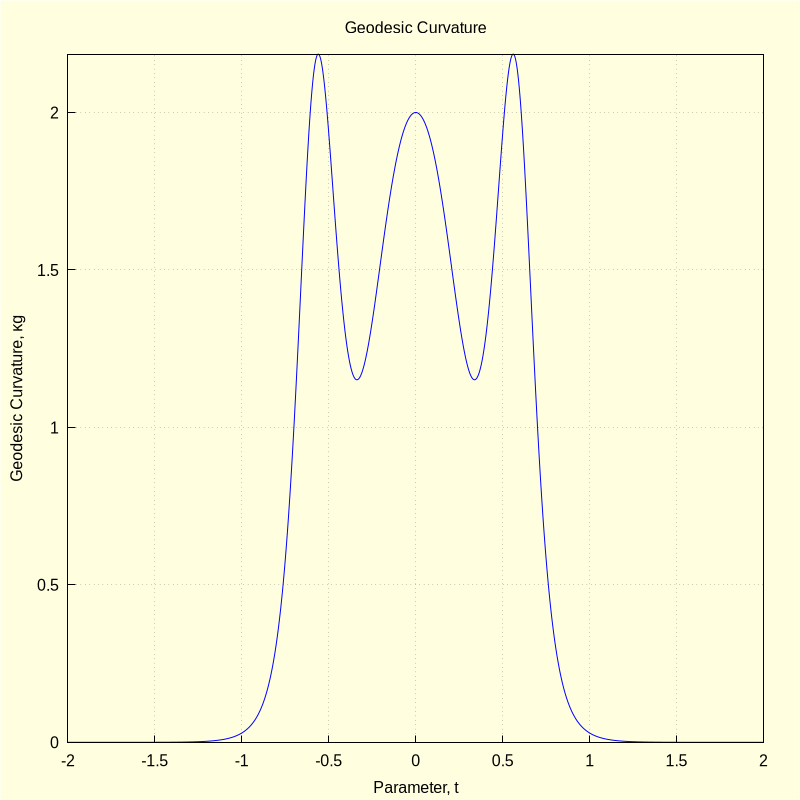
| (%i45) |
wxdraw2d(line_width=1, background_color=light_yellow, xlabel="Parameter, t", ylabel="Normal Curvature, κn", title="Normal Curvature", proportional_axes=none, explicit(κn, t, -2, 2))$ |
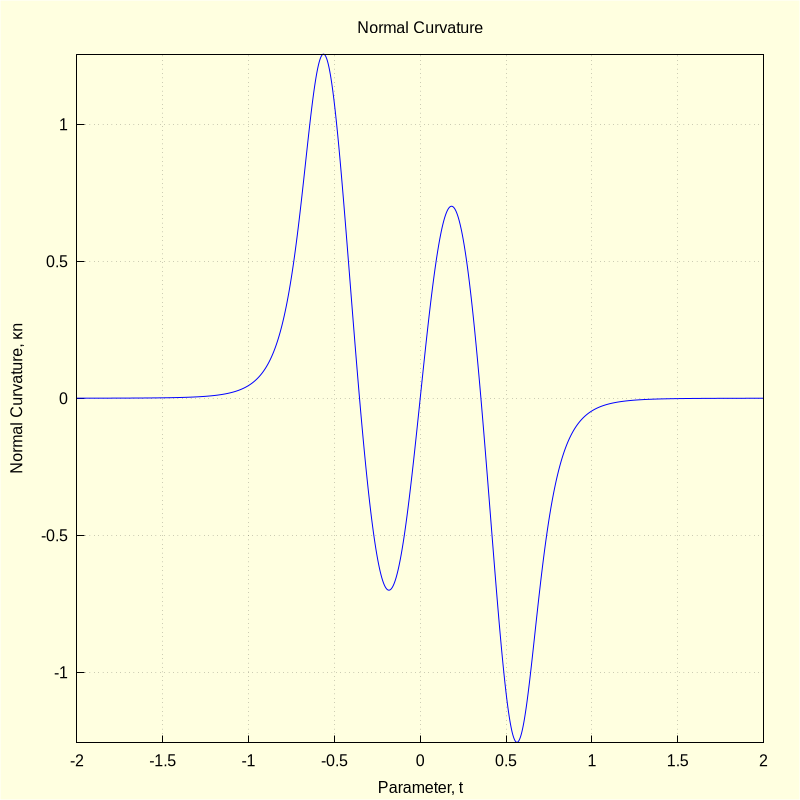
2.3.3 Torsion, \( \tau \), and the geodesic torsion, \( {\tau}g \)
\( \tau = \frac{(c'(t) \times c''(t)) \cdot c'''(t)}{{\lvert c'(t) \times c''(t) \rvert}^2} \)
| (%i46) | τ:ratsimp(tmp1.cttt)/ratsimp(tmp1.tmp1); |
\[ \tau = \frac{12\mathop{-}360 {{t}^{2}}}{8100 {{t}^{8}}\mathop{+}2520 {{t}^{6}}\mathop{-}684 {{t}^{4}}\mathop{+}36 {{t}^{2}}\mathop{+}4}\]
| (%i48) |
ntt:ratsimp(factor(diff(nt,t)))$ τg:factor((ratsimp(ct.(radcan(express(ntt~nt)))))/vel^2); |
\[ {\tau}g = \mathop{-}\left( \frac{6 {{t}^{2}} \left( 45 {{t}^{8}}\mathop{+}36 {{t}^{6}}\mathop{-}9 {{t}^{4}}\mathop{+}4 {{t}^{2}}\mathop{-}5\right) }{\left( 9 {{t}^{8}}\mathop{+}18 {{t}^{6}}\mathop{+}9 {{t}^{4}}\mathop{+}1\right) \, \left( 225 {{t}^{8}}\mathop{-}90 {{t}^{6}}\mathop{+}9 {{t}^{4}}\mathop{+}4 {{t}^{2}}\mathop{+}1\right) }\right) \]
| (%i49) |
wxdraw2d(line_width=1, background_color=light_yellow, xlabel="Parameter, t", ylabel="Geodeic Torsion, τg", title="Geodesic Torsion", proportional_axes=none, grid=true, explicit(τg, t, -2, 2))$ |
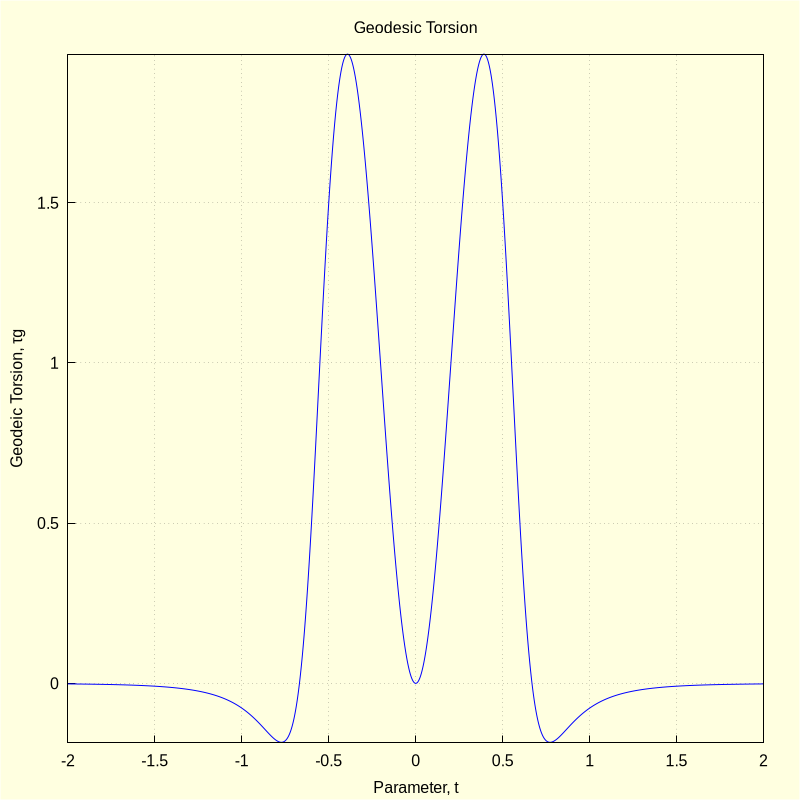
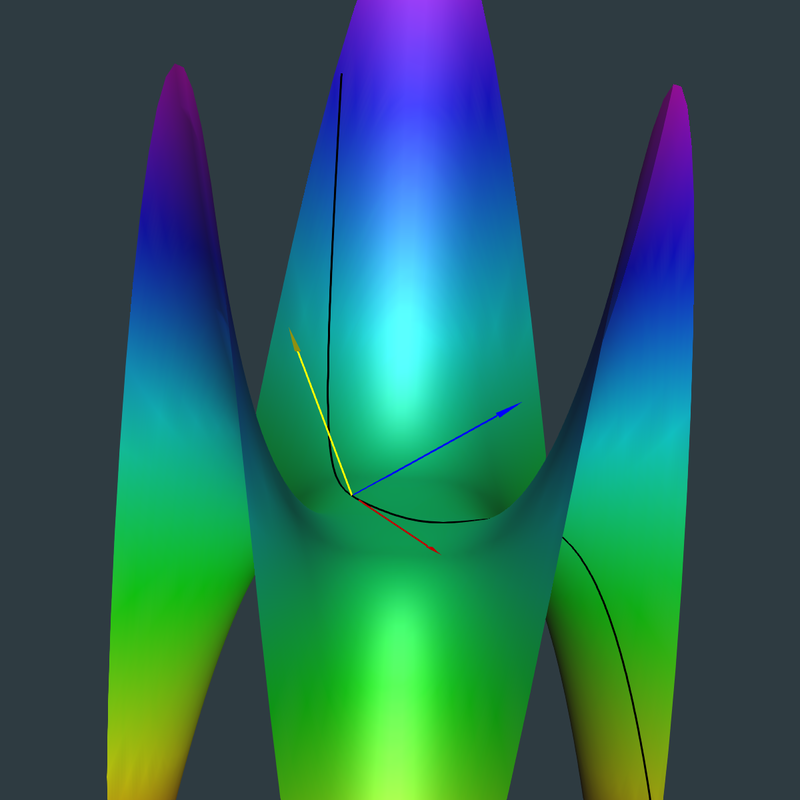
Click Image for Narrated Video
Link for StageTools Script
2.4 Curvature Parameters of the Surface (Monkey Saddle)
2.4.1 We now plot the surface unit normal, n, the curve unit normal, N, and the tangent plane, Tp
| (%i50) | Tp:[f[1]+up*fu[1]+vp*fv[1], f[2]+up*fu[2]+vp*fv[2], f[3]+up*fu[3]+vp*fv[3]]; |
\[ T_p = \left[ \ensuremath{\mathrm{u_p}}\mathop{+}u\mathop{,}\ensuremath{\mathrm{v_p}}\mathop{+}v\mathop{,}\mathop{-}\left( 6 u v\, \ensuremath{\mathrm{v_p}}\right) \mathop{-}3 u {{v}^{2}}\mathop{+}\ensuremath{\mathrm{u_p}}\, \left( 3 {{u}^{2}}\mathop{-}3 {{v}^{2}}\right) \mathop{+}{{u}^{3}}\right] \]
| (%i51) |
/* for plotting along the curve*/ ev(Tp, u=tu, v=tv); |
\[ T_p (along \: c) = \left[ \ensuremath{\mathrm{u_p}}\mathop{+}t\mathop{,}\ensuremath{\mathrm{v_p}}\mathop{+}{{t}^{2}}\mathop{,}\mathop{-}\left( 6 {{t}^{3}} \ensuremath{\mathrm{v_p}}\right) \mathop{+}\left( 3 {{t}^{2}}\mathop{-}3 {{t}^{4}}\right) \, \ensuremath{\mathrm{u_p}}\mathop{-}3 {{t}^{5}}\mathop{+}{{t}^{3}}\right] \]
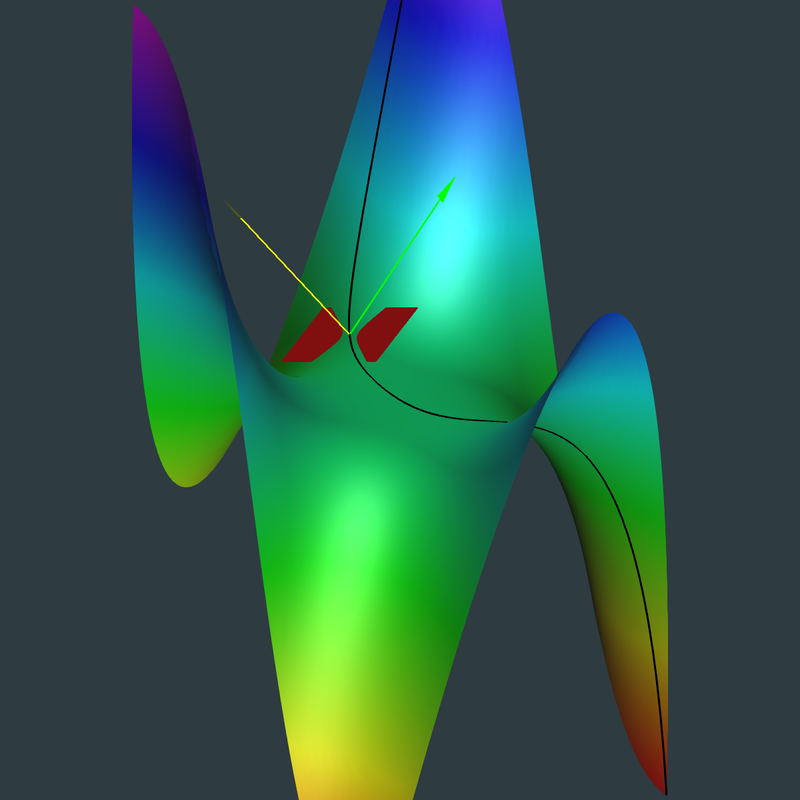
Click Image for Narrated Video
Link for StageTools Script
2.4.2 First differential form (metric), \(g\)
| (%i59) |
E:fu.fu$ F:fu.fv$ G:fv.fv$ g:matrix([E, F],[F, G]); |
\[ g = \begin{bmatrix}{{\left( 3 {{u}^{2}}\mathop{-}3 {{v}^{2}}\right) }^{2}}\mathop{+}1 & \mathop{-}\left( 6 u v\, \left( 3 {{u}^{2}}\mathop{-}3 {{v}^{2}}\right) \right) \\ \mathop{-}\left( 6 u v\, \left( 3 {{u}^{2}}\mathop{-}3 {{v}^{2}}\right) \right) & 36 {{u}^{2}} {{v}^{2}}\mathop{+}1\end{bmatrix}\]
| (%i60) | ratsimp(determinant(g)); |
\[ 9 {{v}^{4}}\mathop{+}18 {{u}^{2}} {{v}^{2}}\mathop{+}9 {{u}^{4}}\mathop{+}1\]
| (%i61) | ginv:ratsimp(invert(g)); |
\[ ginv = \begin{bmatrix}\frac{36 {{u}^{2}} {{v}^{2}}\mathop{+}1}{9 {{v}^{4}}\mathop{+}18 {{u}^{2}} {{v}^{2}}\mathop{+}9 {{u}^{4}}\mathop{+}1} & \mathop{-}\left( \frac{18 u {{v}^{3}}\mathop{-}18 {{u}^{3}} v}{9 {{v}^{4}}\mathop{+}18 {{u}^{2}} {{v}^{2}}\mathop{+}9 {{u}^{4}}\mathop{+}1}\right) \\ \mathop{-}\left( \frac{18 u {{v}^{3}}\mathop{-}18 {{u}^{3}} v}{9 {{v}^{4}}\mathop{+}18 {{u}^{2}} {{v}^{2}}\mathop{+}9 {{u}^{4}}\mathop{+}1}\right) & \frac{9 {{v}^{4}}\mathop{-}18 {{u}^{2}} {{v}^{2}}\mathop{+}9 {{u}^{4}}\mathop{+}1}{9 {{v}^{4}}\mathop{+}18 {{u}^{2}} {{v}^{2}}\mathop{+}9 {{u}^{4}}\mathop{+}1}\end{bmatrix}\]
| (%i62) | ratsimp(g.ginv); |
\[ \begin{bmatrix}1 & 0\\ 0 & 1\end{bmatrix}\]
2.4.3 Second differential form, \( b \)
| (%i66) |
L:diff(fu,u).n$ M:diff(fu,v).n$ NN:diff(fv,v).n$ b:matrix([L, M], [M, NN]); |
\[ b = \begin{bmatrix}\frac{6 u}{\sqrt{9 {{v}^{4}}\mathop{+}18 {{u}^{2}} {{v}^{2}}\mathop{+}9 {{u}^{4}}\mathop{+}1}} & \mathop{-}\left( \frac{6 v}{\sqrt{9 {{v}^{4}}\mathop{+}18 {{u}^{2}} {{v}^{2}}\mathop{+}9 {{u}^{4}}\mathop{+}1}}\right) \\ \mathop{-}\left( \frac{6 v}{\sqrt{9 {{v}^{4}}\mathop{+}18 {{u}^{2}} {{v}^{2}}\mathop{+}9 {{u}^{4}}\mathop{+}1}}\right) & \mathop{-}\left( \frac{6 u}{\sqrt{9 {{v}^{4}}\mathop{+}18 {{u}^{2}} {{v}^{2}}\mathop{+}9 {{u}^{4}}\mathop{+}1}}\right) \end{bmatrix}\]
2.4.4 Shape operator, \( Sp \)
The coefficients can be found by taking the partial derivatives of the surface normal with respect to the surface parameters:
\[ Sp_u = \frac{\partial \mathbf{n}}{\partial u} \]
\[ Sp_v = \frac{\partial \mathbf{n}}{\partial v} \]
We use this method as it will be useful immediately below.
| (%i67) | Sp:factor(ratsimp(expand(ginv.b))); |
\[ Sp = \begin{bmatrix}\frac{6 u\, \left( 18 {{v}^{4}}\mathop{+}18 {{u}^{2}} {{v}^{2}}\mathop{+}1\right) }{{{\left( 9 {{v}^{4}}\mathop{+}18 {{u}^{2}} {{v}^{2}}\mathop{+}9 {{u}^{4}}\mathop{+}1\right) }^{\frac{3}{2}}}} & \mathop{-}\left( \frac{6 v\, \left( 18 {{u}^{2}} {{v}^{2}}\mathop{+}18 {{u}^{4}}\mathop{+}1\right) }{{{\left( 9 {{v}^{4}}\mathop{+}18 {{u}^{2}} {{v}^{2}}\mathop{+}9 {{u}^{4}}\mathop{+}1\right) }^{\frac{3}{2}}}}\right) \\ \mathop{-}\left( \frac{6 v\, \left( 9 {{v}^{4}}\mathop{-}9 {{u}^{4}}\mathop{+}1\right) }{{{\left( 9 {{v}^{4}}\mathop{+}18 {{u}^{2}} {{v}^{2}}\mathop{+}9 {{u}^{4}}\mathop{+}1\right) }^{\frac{3}{2}}}}\right) & \frac{6 u\, \left( 9 {{v}^{4}}\mathop{-}9 {{u}^{4}}\mathop{-}1\right) }{{{\left( 9 {{v}^{4}}\mathop{+}18 {{u}^{2}} {{v}^{2}}\mathop{+}9 {{u}^{4}}\mathop{+}1\right) }^{\frac{3}{2}}}}\end{bmatrix}\]
2.4.5 Principal curvatures of the surface
| (%i68) | [spvals,spvects]:eigenvectors(Sp)$ |
| (%i70) |
pc1:factor(radcan(ratsimp(spvals)))[1][1]; pc2:factor(radcan(ratsimp(spvals)))[1][2]; |
\[ Sp_{val1} = \mathop{-}\left( \frac{3 \left( \sqrt{{{v}^{2}}\mathop{+}{{u}^{2}}} \sqrt{729 {{u}^{2}} {{v}^{6}}\mathop{+}\left( 243 {{u}^{4}}\mathop{+}36\right) {{v}^{4}}\mathop{+}\left( 72 {{u}^{2}}\mathop{-}405 {{u}^{6}}\right) {{v}^{2}}\mathop{+}81 {{u}^{8}}\mathop{+}36 {{u}^{4}}\mathop{+}4}\mathop{-}27 u {{v}^{4}}\mathop{-}18 {{u}^{3}} {{v}^{2}}\mathop{+}9 {{u}^{5}}\right) }{{{\left( 9 {{v}^{4}}\mathop{+}18 {{u}^{2}} {{v}^{2}}\mathop{+}9 {{u}^{4}}\mathop{+}1\right) }^{\frac{3}{2}}}}\right) \]
\[ Sp_{val2} = \frac{3 \left( \sqrt{{{v}^{2}}\mathop{+}{{u}^{2}}} \sqrt{729 {{u}^{2}} {{v}^{6}}\mathop{+}\left( 243 {{u}^{4}}\mathop{+}36\right) {{v}^{4}}\mathop{+}\left( 72 {{u}^{2}}\mathop{-}405 {{u}^{6}}\right) {{v}^{2}}\mathop{+}81 {{u}^{8}}\mathop{+}36 {{u}^{4}}\mathop{+}4}\mathop{+}27 u {{v}^{4}}\mathop{+}18 {{u}^{3}} {{v}^{2}}\mathop{-}9 {{u}^{5}}\right) }{{{\left( 9 {{v}^{4}}\mathop{+}18 {{u}^{2}} {{v}^{2}}\mathop{+}9 {{u}^{4}}\mathop{+}1\right) }^{\frac{3}{2}}}}\]
The PC values are defined anywhere on the surface but here they are plotted only along the embedded curve.
| (%i73) |
pc1t:ev(pc1, u=tu, v=tv)$ pc2t:ev(pc2, u=tu, v=tv)$ wxdraw2d(line_width=1, background_color=light_yellow, xlabel="Parameter, t", ylabel="Principal Curvature: pc1 (green), pc2 (blue)", title="Principal Curvatures", proportional_axes=none, grid=true, color=dark_green, explicit(pc1t, t, -2, 2), color=blue, explicit(pc2t, t, -2, 2) )$ |
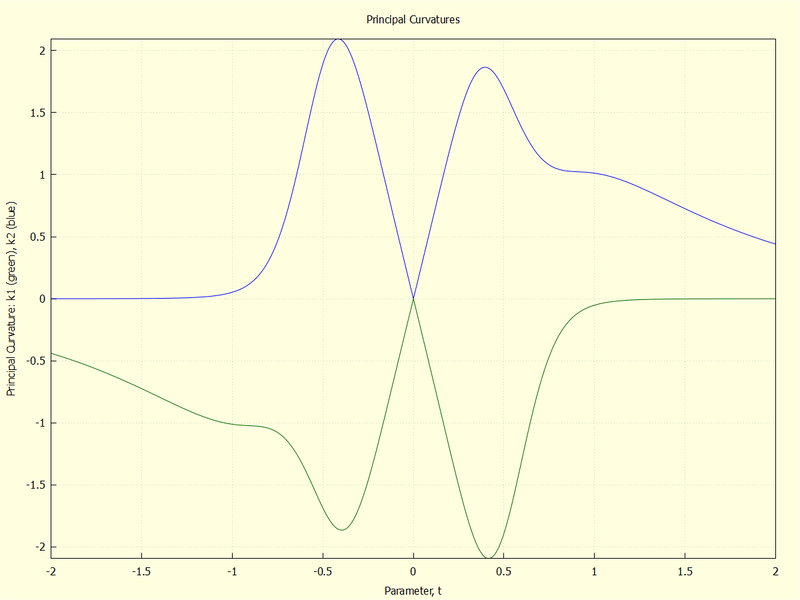
\[ spvects[1][1] \cdot fu + spvects[1][2] \cdot fv\] \[ spvects[2][1] \cdot fu + spvects[2][2] \cdot fv\] The eigenvectors are now shown:
| (%i75) |
spvec1:radcan(spvects[1][1]); spvec2:radcan(spvects[2][1]); |
\[ Sp_{vec2} = \left[ 1\mathop{,}\mathop{-}\left( \frac{\sqrt{{{v}^{2}}\mathop{+}{{u}^{2}}} \sqrt{729 {{u}^{2}} {{v}^{6}}\mathop{+}\left( 243 {{u}^{4}}\mathop{+}36\right) {{v}^{4}}\mathop{+}\left( 72 {{u}^{2}}\mathop{-}405 {{u}^{6}}\right) {{v}^{2}}\mathop{+}81 {{u}^{8}}\mathop{+}36 {{u}^{4}}\mathop{+}4}\mathop{-}9 u {{v}^{4}}\mathop{-}18 {{u}^{3}} {{v}^{2}}\mathop{-}9 {{u}^{5}}\mathop{-}2 u}{36 {{u}^{2}} {{v}^{3}}\mathop{+}\left( 36 {{u}^{4}}\mathop{+}2\right) v}\right) \right] \]
This is done by first computing the PC vectors according to the formula above and then taking the dot product:
| (%i76) | tmp2:(spvec1[1]*fu+spvec1[2]*fv).(spvec2[1]*fu+spvec2[2]*fv); |
\[ \left( \frac{6 u v\, \left( \sqrt{{{v}^{2}}\mathop{+}{{u}^{2}}} \sqrt{729 {{u}^{2}} {{v}^{6}}\mathop{+}\left( 243 {{u}^{4}}\mathop{+}36\right) {{v}^{4}}\mathop{+}\left( 72 {{u}^{2}}\mathop{-}405 {{u}^{6}}\right) {{v}^{2}}\mathop{+}81 {{u}^{8}}\mathop{+}36 {{u}^{4}}\mathop{+}4}\mathop{-}9 u {{v}^{4}}\mathop{-}18 {{u}^{3}} {{v}^{2}}\mathop{-}9 {{u}^{5}}\mathop{-}2 u\right) }{36 {{u}^{2}} {{v}^{3}}\mathop{+}\left( 36 {{u}^{4}}\mathop{+}2\right) v}\mathop{-}3 {{v}^{2}}\mathop{+}3 {{u}^{2}}\right) \, \left( \mathop{-}\left( \frac{6 u v\, \left( \sqrt{{{v}^{2}}\mathop{+}{{u}^{2}}} \sqrt{729 {{u}^{2}} {{v}^{6}}\mathop{+}\left( 243 {{u}^{4}}\mathop{+}36\right) {{v}^{4}}\mathop{+}\left( 72 {{u}^{2}}\mathop{-}405 {{u}^{6}}\right) {{v}^{2}}\mathop{+}81 {{u}^{8}}\mathop{+}36 {{u}^{4}}\mathop{+}4}\mathop{+}9 u {{v}^{4}}\mathop{+}18 {{u}^{3}} {{v}^{2}}\mathop{+}9 {{u}^{5}}\mathop{+}2 u\right) }{36 {{u}^{2}} {{v}^{3}}\mathop{+}\left( 36 {{u}^{4}}\mathop{+}2\right) v}\right) \mathop{-}3 {{v}^{2}}\mathop{+}3 {{u}^{2}}\right) \mathop{-}\mathop{(}\left( \sqrt{{{v}^{2}}\mathop{+}{{u}^{2}}} \sqrt{729 {{u}^{2}} {{v}^{6}}\mathop{+}\left( 243 {{u}^{4}}\mathop{+}36\right) {{v}^{4}}\mathop{+}\left( 72 {{u}^{2}}\mathop{-}405 {{u}^{6}}\right) {{v}^{2}}\mathop{+}81 {{u}^{8}}\mathop{+}36 {{u}^{4}}\mathop{+}4}\mathop{-}9 u {{v}^{4}}\mathop{-}18 {{u}^{3}} {{v}^{2}}\mathop{-}9 {{u}^{5}}\mathop{-}2 u\right) \, \left( \sqrt{{{v}^{2}}\mathop{+}{{u}^{2}}} \sqrt{729 {{u}^{2}} {{v}^{6}}\mathop{+}\left( 243 {{u}^{4}}\mathop{+}36\right) {{v}^{4}}\mathop{+}\left( 72 {{u}^{2}}\mathop{-}405 {{u}^{6}}\right) {{v}^{2}}\mathop{+}81 {{u}^{8}}\mathop{+}36 {{u}^{4}}\mathop{+}4}\mathop{+}9 u {{v}^{4}}\mathop{+}18 {{u}^{3}} {{v}^{2}}\mathop{+}9 {{u}^{5}}\mathop{+}2 u\right) \mathop{)}/{{\left( 36 {{u}^{2}} {{v}^{3}}\mathop{+}\left( 36 {{u}^{4}}\mathop{+}2\right) v\right) }^{2}}\mathop{+}1\]
| (%i77) | ratsimp(tmp2); |
\[ 0\]
The resulting expressions are very complex but Maxima/wxMaxima handles them with ease.
| (%i79) |
tmp3:fullratsimp(ev(spvec1[1]*fu+spvec1[2]*fv, u=tu, v=tv))$ pcv1:fullratsimp(tmp3/fullratsimp(sqrt(tmp3.tmp3))); |
\[ \mathbf{pcv1} = \mathop{[} \frac{\sqrt{648 {{u}^{4}} {{v}^{6}}\mathop{+}\left( 1296 {{u}^{6}}\mathop{+}72 {{u}^{2}}\right) {{v}^{4}}\mathop{+}\left( 648 {{u}^{8}}\mathop{+}72 {{u}^{4}}\mathop{+}2\right) {{v}^{2}}}}{\sqrt{26244 {{u}^{4}} {{v}^{10}}\mathop{+}\left( 34992 {{u}^{6}}\mathop{+}2025 {{u}^{2}}\right) {{v}^{8}}\mathop{+}\sqrt{{{v}^{2}}\mathop{+}{{u}^{2}}} \sqrt{729 {{u}^{2}} {{v}^{6}}\mathop{+}\left( 243 {{u}^{4}}\mathop{+}36\right) {{v}^{4}}\mathop{+}\left( 72 {{u}^{2}}\mathop{-}405 {{u}^{6}}\right) {{v}^{2}}\mathop{+}81 {{u}^{8}}\mathop{+}36 {{u}^{4}}\mathop{+}4} \left( 972 {{u}^{3}} {{v}^{6}}\mathop{+}\left( 648 {{u}^{5}}\mathop{+}45 u\right) {{v}^{4}}\mathop{+}\left( 54 {{u}^{3}}\mathop{-}324 {{u}^{7}}\right) {{v}^{2}}\mathop{+}9 {{u}^{5}}\mathop{+}2 u\right) \mathop{+}\left( \mathop{-}\left( 5832 {{u}^{8}}\right) \mathop{+}4860 {{u}^{4}}\mathop{+}36\right) {{v}^{6}}\mathop{+}\left( \mathop{-}\left( 11664 {{u}^{10}}\right) \mathop{+}3726 {{u}^{6}}\mathop{+}252 {{u}^{2}}\right) {{v}^{4}}\mathop{+}\left( 2916 {{u}^{12}}\mathop{+}972 {{u}^{8}}\mathop{+}252 {{u}^{4}}\mathop{+}4\right) {{v}^{2}}\mathop{+}81 {{u}^{10}}\mathop{+}36 {{u}^{6}}\mathop{+}4 {{u}^{2}}}} \mathop{,} \frac{\sqrt{648 {{u}^{4}} {{v}^{6}}\mathop{+}\left( 1296 {{u}^{6}}\mathop{+}72 {{u}^{2}}\right) {{v}^{4}}\mathop{+}\left( 648 {{u}^{8}}\mathop{+}72 {{u}^{4}}\mathop{+}2\right) {{v}^{2}}} \left( \sqrt{{{v}^{2}}\mathop{+}{{u}^{2}}} \sqrt{729 {{u}^{2}} {{v}^{6}}\mathop{+}\left( 243 {{u}^{4}}\mathop{+}36\right) {{v}^{4}}\mathop{+}\left( 72 {{u}^{2}}\mathop{-}405 {{u}^{6}}\right) {{v}^{2}}\mathop{+}81 {{u}^{8}}\mathop{+}36 {{u}^{4}}\mathop{+}4}\mathop{+}9 u {{v}^{4}}\mathop{+}18 {{u}^{3}} {{v}^{2}}\mathop{+}9 {{u}^{5}}\mathop{+}2 u\right) }{\left( 36 {{u}^{2}} {{v}^{3}}\mathop{+}\left( 36 {{u}^{4}}\mathop{+}2\right) v\right) \sqrt{26244 {{u}^{4}} {{v}^{10}}\mathop{+}\left( 34992 {{u}^{6}}\mathop{+}2025 {{u}^{2}}\right) {{v}^{8}}\mathop{+}\sqrt{{{v}^{2}}\mathop{+}{{u}^{2}}} \sqrt{729 {{u}^{2}} {{v}^{6}}\mathop{+}\left( 243 {{u}^{4}}\mathop{+}36\right) {{v}^{4}}\mathop{+}\left( 72 {{u}^{2}}\mathop{-}405 {{u}^{6}}\right) {{v}^{2}}\mathop{+}81 {{u}^{8}}\mathop{+}36 {{u}^{4}}\mathop{+}4} \left( 972 {{u}^{3}} {{v}^{6}}\mathop{+}\left( 648 {{u}^{5}}\mathop{+}45 u\right) {{v}^{4}}\mathop{+}\left( 54 {{u}^{3}}\mathop{-}324 {{u}^{7}}\right) {{v}^{2}}\mathop{+}9 {{u}^{5}}\mathop{+}2 u\right) \mathop{+}\left( \mathop{-}\left( 5832 {{u}^{8}}\right) \mathop{+}4860 {{u}^{4}}\mathop{+}36\right) {{v}^{6}}\mathop{+}\left( \mathop{-}\left( 11664 {{u}^{10}}\right) \mathop{+}3726 {{u}^{6}}\mathop{+}252 {{u}^{2}}\right) {{v}^{4}}\mathop{+}\left( 2916 {{u}^{12}}\mathop{+}972 {{u}^{8}}\mathop{+}252 {{u}^{4}}\mathop{+}4\right) {{v}^{2}}\mathop{+}81 {{u}^{10}}\mathop{+}36 {{u}^{6}}\mathop{+}4 {{u}^{2}}}} \mathop{,} \mathop{-}\left( \frac{\sqrt{648 {{u}^{4}} {{v}^{6}}\mathop{+}\left( 1296 {{u}^{6}}\mathop{+}72 {{u}^{2}}\right) {{v}^{4}}\mathop{+}\left( 648 {{u}^{8}}\mathop{+}72 {{u}^{4}}\mathop{+}2\right) {{v}^{2}}} \left( 3 u \sqrt{{{v}^{2}}\mathop{+}{{u}^{2}}} \sqrt{729 {{u}^{2}} {{v}^{6}}\mathop{+}\left( 243 {{u}^{4}}\mathop{+}36\right) {{v}^{4}}\mathop{+}\left( 72 {{u}^{2}}\mathop{-}405 {{u}^{6}}\right) {{v}^{2}}\mathop{+}81 {{u}^{8}}\mathop{+}36 {{u}^{4}}\mathop{+}4}\mathop{+}81 {{u}^{2}} {{v}^{4}}\mathop{+}\left( 54 {{u}^{4}}\mathop{+}3\right) {{v}^{2}}\mathop{-}27 {{u}^{6}}\mathop{+}3 {{u}^{2}}\right) }{\left( 18 {{u}^{2}} {{v}^{2}}\mathop{+}18 {{u}^{4}}\mathop{+}1\right) \sqrt{26244 {{u}^{4}} {{v}^{10}}\mathop{+}\left( 34992 {{u}^{6}}\mathop{+}2025 {{u}^{2}}\right) {{v}^{8}}\mathop{+}\sqrt{{{v}^{2}}\mathop{+}{{u}^{2}}} \sqrt{729 {{u}^{2}} {{v}^{6}}\mathop{+}\left( 243 {{u}^{4}}\mathop{+}36\right) {{v}^{4}}\mathop{+}\left( 72 {{u}^{2}}\mathop{-}405 {{u}^{6}}\right) {{v}^{2}}\mathop{+}81 {{u}^{8}}\mathop{+}36 {{u}^{4}}\mathop{+}4} \left( 972 {{u}^{3}} {{v}^{6}}\mathop{+}\left( 648 {{u}^{5}}\mathop{+}45 u\right) {{v}^{4}}\mathop{+}\left( 54 {{u}^{3}}\mathop{-}324 {{u}^{7}}\right) {{v}^{2}}\mathop{+}9 {{u}^{5}}\mathop{+}2 u\right) \mathop{+}\left( \mathop{-}\left( 5832 {{u}^{8}}\right) \mathop{+}4860 {{u}^{4}}\mathop{+}36\right) {{v}^{6}}\mathop{+}\left( \mathop{-}\left( 11664 {{u}^{10}}\right) \mathop{+}3726 {{u}^{6}}\mathop{+}252 {{u}^{2}}\right) {{v}^{4}}\mathop{+}\left( 2916 {{u}^{12}}\mathop{+}972 {{u}^{8}}\mathop{+}252 {{u}^{4}}\mathop{+}4\right) {{v}^{2}}\mathop{+}81 {{u}^{10}}\mathop{+}36 {{u}^{6}}\mathop{+}4 {{u}^{2}}}}\right) \mathop{]} \]
| (%i81) |
tmp3:fullratsimp(ev(spvec2[1]*fu+spvec2[2]*fv, u=tu, v=tv))$ pcv2:fullratsimp(tmp3/fullratsimp(sqrt(tmp3.tmp3))); |
\[ \mathbf{pcv2} = \mathop{[} \frac{\sqrt{648 {{u}^{4}} {{v}^{6}}\mathop{+}\left( 1296 {{u}^{6}}\mathop{+}72 {{u}^{2}}\right) {{v}^{4}}\mathop{+}\left( 648 {{u}^{8}}\mathop{+}72 {{u}^{4}}\mathop{+}2\right) {{v}^{2}}}}{\sqrt{26244 {{u}^{4}} {{v}^{10}}\mathop{+}\left( 34992 {{u}^{6}}\mathop{+}2025 {{u}^{2}}\right) {{v}^{8}}\mathop{+}\sqrt{{{v}^{2}}\mathop{+}{{u}^{2}}} \sqrt{729 {{u}^{2}} {{v}^{6}}\mathop{+}\left( 243 {{u}^{4}}\mathop{+}36\right) {{v}^{4}}\mathop{+}\left( 72 {{u}^{2}}\mathop{-}405 {{u}^{6}}\right) {{v}^{2}}\mathop{+}81 {{u}^{8}}\mathop{+}36 {{u}^{4}}\mathop{+}4} \left( \mathop{-}\left( 972 {{u}^{3}} {{v}^{6}}\right) \mathop{+}\left( \mathop{-}\left( 648 {{u}^{5}}\right) \mathop{-}45 u\right) {{v}^{4}}\mathop{+}\left( 324 {{u}^{7}}\mathop{-}54 {{u}^{3}}\right) {{v}^{2}}\mathop{-}9 {{u}^{5}}\mathop{-}2 u\right) \mathop{+}\left( \mathop{-}\left( 5832 {{u}^{8}}\right) \mathop{+}4860 {{u}^{4}}\mathop{+}36\right) {{v}^{6}}\mathop{+}\left( \mathop{-}\left( 11664 {{u}^{10}}\right) \mathop{+}3726 {{u}^{6}}\mathop{+}252 {{u}^{2}}\right) {{v}^{4}}\mathop{+}\left( 2916 {{u}^{12}}\mathop{+}972 {{u}^{8}}\mathop{+}252 {{u}^{4}}\mathop{+}4\right) {{v}^{2}}\mathop{+}81 {{u}^{10}}\mathop{+}36 {{u}^{6}}\mathop{+}4 {{u}^{2}}}} \mathop{,} \mathop{-} \left( \frac{\sqrt{648 {{u}^{4}} {{v}^{6}}\mathop{+}\left( 1296 {{u}^{6}}\mathop{+}72 {{u}^{2}}\right) {{v}^{4}}\mathop{+}\left( 648 {{u}^{8}}\mathop{+}72 {{u}^{4}}\mathop{+}2\right) {{v}^{2}}} \left( \sqrt{{{v}^{2}}\mathop{+}{{u}^{2}}} \sqrt{729 {{u}^{2}} {{v}^{6}}\mathop{+}\left( 243 {{u}^{4}}\mathop{+}36\right) {{v}^{4}}\mathop{+}\left( 72 {{u}^{2}}\mathop{-}405 {{u}^{6}}\right) {{v}^{2}}\mathop{+}81 {{u}^{8}}\mathop{+}36 {{u}^{4}}\mathop{+}4}\mathop{-}9 u {{v}^{4}}\mathop{-}18 {{u}^{3}} {{v}^{2}}\mathop{-}9 {{u}^{5}}\mathop{-}2 u\right) }{\left( 36 {{u}^{2}} {{v}^{3}}\mathop{+}\left( 36 {{u}^{4}}\mathop{+}2\right) v\right) \sqrt{26244 {{u}^{4}} {{v}^{10}}\mathop{+}\left( 34992 {{u}^{6}}\mathop{+}2025 {{u}^{2}}\right) {{v}^{8}}\mathop{+}\sqrt{{{v}^{2}}\mathop{+}{{u}^{2}}} \sqrt{729 {{u}^{2}} {{v}^{6}}\mathop{+}\left( 243 {{u}^{4}}\mathop{+}36\right) {{v}^{4}}\mathop{+}\left( 72 {{u}^{2}}\mathop{-}405 {{u}^{6}}\right) {{v}^{2}}\mathop{+}81 {{u}^{8}}\mathop{+}36 {{u}^{4}}\mathop{+}4} \left( \mathop{-}\left( 972 {{u}^{3}} {{v}^{6}}\right) \mathop{+}\left( \mathop{-}\left( 648 {{u}^{5}}\right) \mathop{-}45 u\right) {{v}^{4}}\mathop{+}\left( 324 {{u}^{7}}\mathop{-}54 {{u}^{3}}\right) {{v}^{2}}\mathop{-}9 {{u}^{5}}\mathop{-}2 u\right) \mathop{+}\left( \mathop{-}\left( 5832 {{u}^{8}}\right) \mathop{+}4860 {{u}^{4}}\mathop{+}36\right) {{v}^{6}}\mathop{+}\left( \mathop{-}\left( 11664 {{u}^{10}}\right) \mathop{+}3726 {{u}^{6}}\mathop{+}252 {{u}^{2}}\right) {{v}^{4}}\mathop{+}\left( 2916 {{u}^{12}}\mathop{+}972 {{u}^{8}}\mathop{+}252 {{u}^{4}}\mathop{+}4\right) {{v}^{2}}\mathop{+}81 {{u}^{10}}\mathop{+}36 {{u}^{6}}\mathop{+}4 {{u}^{2}}}}\right) \mathop{,} \frac{\sqrt{648 {{u}^{4}} {{v}^{6}}\mathop{+}\left( 1296 {{u}^{6}}\mathop{+}72 {{u}^{2}}\right) {{v}^{4}}\mathop{+}\left( 648 {{u}^{8}}\mathop{+}72 {{u}^{4}}\mathop{+}2\right) {{v}^{2}}} \left( 3 u \sqrt{{{v}^{2}}\mathop{+}{{u}^{2}}} \sqrt{729 {{u}^{2}} {{v}^{6}}\mathop{+}\left( 243 {{u}^{4}}\mathop{+}36\right) {{v}^{4}}\mathop{+}\left( 72 {{u}^{2}}\mathop{-}405 {{u}^{6}}\right) {{v}^{2}}\mathop{+}81 {{u}^{8}}\mathop{+}36 {{u}^{4}}\mathop{+}4}\mathop{-}81 {{u}^{2}} {{v}^{4}}\mathop{+}\left( \mathop{-}\left( 54 {{u}^{4}}\right) \mathop{-}3\right) {{v}^{2}}\mathop{+}27 {{u}^{6}}\mathop{-}3 {{u}^{2}}\right) }{\left( 18 {{u}^{2}} {{v}^{2}}\mathop{+}18 {{u}^{4}}\mathop{+}1\right) \sqrt{26244 {{u}^{4}} {{v}^{10}}\mathop{+}\left( 34992 {{u}^{6}}\mathop{+}2025 {{u}^{2}}\right) {{v}^{8}}\mathop{+}\sqrt{{{v}^{2}}\mathop{+}{{u}^{2}}} \sqrt{729 {{u}^{2}} {{v}^{6}}\mathop{+}\left( 243 {{u}^{4}}\mathop{+}36\right) {{v}^{4}}\mathop{+}\left( 72 {{u}^{2}}\mathop{-}405 {{u}^{6}}\right) {{v}^{2}}\mathop{+}81 {{u}^{8}}\mathop{+}36 {{u}^{4}}\mathop{+}4} \left( \mathop{-}\left( 972 {{u}^{3}} {{v}^{6}}\right) \mathop{+}\left( \mathop{-}\left( 648 {{u}^{5}}\right) \mathop{-}45 u\right) {{v}^{4}}\mathop{+}\left( 324 {{u}^{7}}\mathop{-}54 {{u}^{3}}\right) {{v}^{2}}\mathop{-}9 {{u}^{5}}\mathop{-}2 u\right) \mathop{+}\left( \mathop{-}\left( 5832 {{u}^{8}}\right) \mathop{+}4860 {{u}^{4}}\mathop{+}36\right) {{v}^{6}}\mathop{+}\left( \mathop{-}\left( 11664 {{u}^{10}}\right) \mathop{+}3726 {{u}^{6}}\mathop{+}252 {{u}^{2}}\right) {{v}^{4}}\mathop{+}\left( 2916 {{u}^{12}}\mathop{+}972 {{u}^{8}}\mathop{+}252 {{u}^{4}}\mathop{+}4\right) {{v}^{2}}\mathop{+}81 {{u}^{10}}\mathop{+}36 {{u}^{6}}\mathop{+}4 {{u}^{2}}}} \]
| (%i85) |
fullratsimp(pcv1.pcv1); fullratsimp(pcv2.pcv2); fullratsimp(pcv1.n); fullratsimp(pcv2.n); |
\[ 1\]
\[ 1\]
\[ 0\]
\[ 0\]
For a Geomview/StageTools animated graphic click the image (opens in new window).
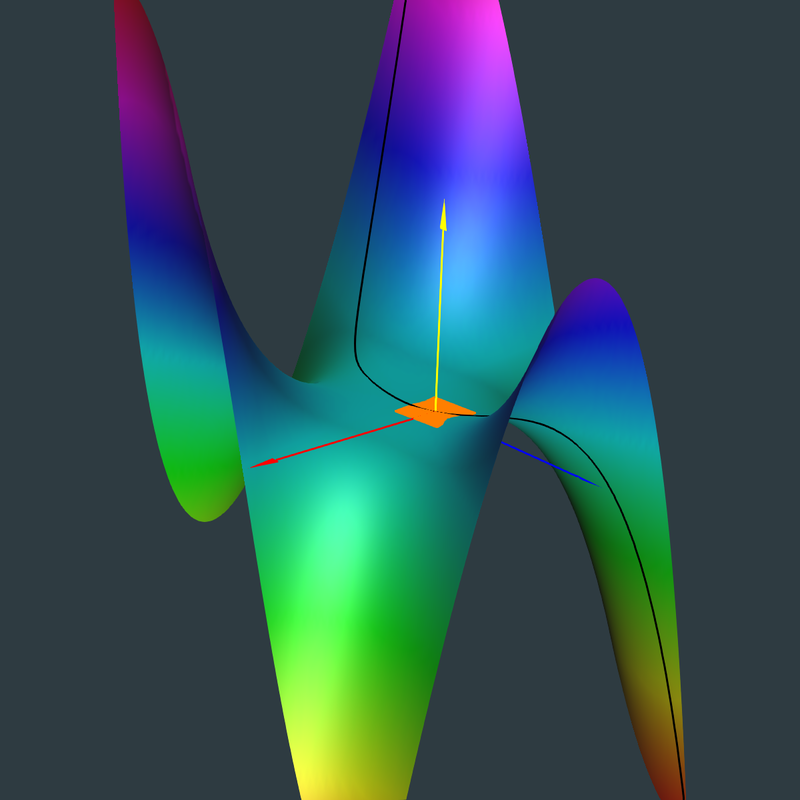
Click Image for Video
Link for StageTools Script
2.5 The Christoffel symbols
| (%i63) | load ( ctensor ) $ |
| init_ctensor ( ) $ |
|
dim
:
2
$
ct_coords
:
[
u
,
v
]
$
lg : g $ ug : ginv $ |
| (%i69) | christof ( mcs ) $ |
The pattern is \( \Gamma_{jk}^i = mcs(j, k, i) \)
|
Γ111
:
mcs
[
1
,
1
,
1
]
;
Γ112 : mcs [ 1 , 2 , 1 ] ; Γ121 : mcs [ 2 , 1 , 1 ] ; Γ122 : mcs [ 2 , 2 , 1 ] ; Γ211 : mcs [ 1 , 1 , 2 ] ; Γ212 : mcs [ 1 , 2 , 2 ] ; Γ221 : mcs [ 2 , 1 , 2 ] ; Γ222 : mcs [ 2 , 2 , 2 ] ; |
\[ \Gamma^{1}_{11} = \mathop{-}\left( \frac{18 u {{v}^{2}}\mathop{-}18 {{u}^{3}}}{9 {{v}^{4}}\mathop{+}18 {{u}^{2}} {{v}^{2}}\mathop{+}9 {{u}^{4}}\mathop{+}1}\right) \]
\[ \Gamma^{1}_{12} = \frac{18 {{v}^{3}}\mathop{-}18 {{u}^{2}} v}{9 {{v}^{4}}\mathop{+}18 {{u}^{2}} {{v}^{2}}\mathop{+}9 {{u}^{4}}\mathop{+}1}\]
\[ \Gamma^{1}_{21} = \frac{18 {{v}^{3}}\mathop{-}18 {{u}^{2}} v}{9 {{v}^{4}}\mathop{+}18 {{u}^{2}} {{v}^{2}}\mathop{+}9 {{u}^{4}}\mathop{+}1}\]
\[ \Gamma^{1}_{22} = \frac{18 u {{v}^{2}}\mathop{-}18 {{u}^{3}}}{9 {{v}^{4}}\mathop{+}18 {{u}^{2}} {{v}^{2}}\mathop{+}9 {{u}^{4}}\mathop{+}1}\]
\[ \Gamma^{2}_{11} = \mathop{-}\left( \frac{36 {{u}^{2}} v}{9 {{v}^{4}}\mathop{+}18 {{u}^{2}} {{v}^{2}}\mathop{+}9 {{u}^{4}}\mathop{+}1}\right) \]
\[ \Gamma^{2}_{12} = \frac{36 u {{v}^{2}}}{9 {{v}^{4}}\mathop{+}18 {{u}^{2}} {{v}^{2}}\mathop{+}9 {{u}^{4}}\mathop{+}1}\]
\[ \Gamma^{2}_{21} = \frac{36 u {{v}^{2}}}{9 {{v}^{4}}\mathop{+}18 {{u}^{2}} {{v}^{2}}\mathop{+}9 {{u}^{4}}\mathop{+}1}\]
\[ \Gamma^{2}_{22} = \frac{36 {{u}^{2}} v}{9 {{v}^{4}}\mathop{+}18 {{u}^{2}} {{v}^{2}}\mathop{+}9 {{u}^{4}}\mathop{+}1}\]
2.6 Geodesics of the Monkey Saddle Surface
The trivial geodesics are the initial coordinate curves: \( [0, t, 0], [t,0,t^3] \)
|
ev(f, u=0, v=t); ev(f, u=t, v=0); |
\[ \left[ 0\mathop{,}t\mathop{,}0\right] \]
\[ \left[ t\mathop{,}0\mathop{,}{{t}^{3}}\right] \]
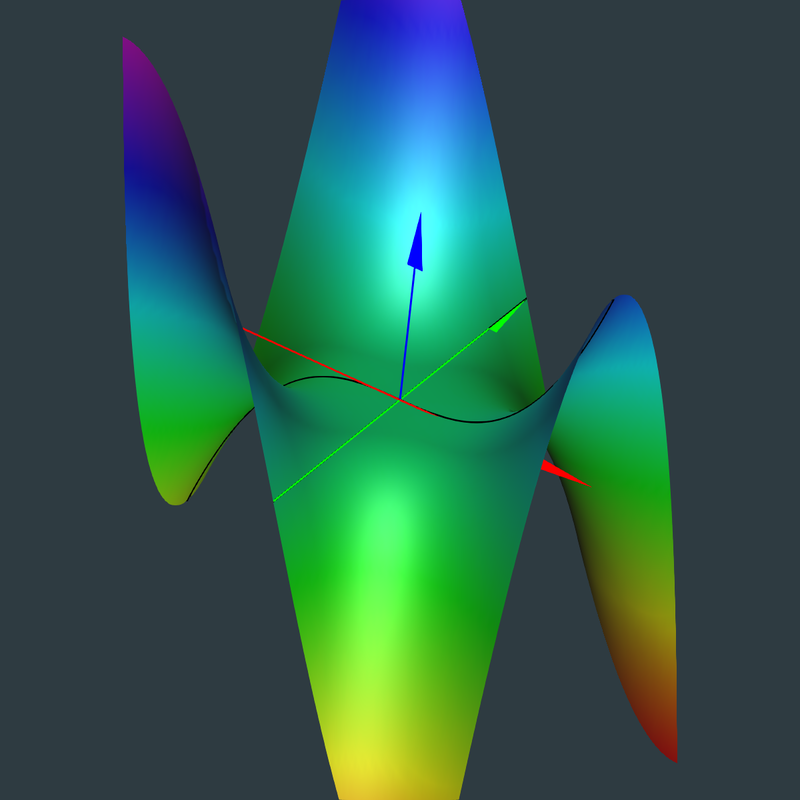
Click Image for Video
Link for StageTools Script
\[ u''(t) + \Gamma_{11}^1 u'(t)^2 + 2 \Gamma_{12}^1 u'(t) v'(t) + \Gamma_{22}^1 v'(t)^2 = 0 \]
\[ v''(t) + \Gamma_{11}^2 u'(t)^2 + 2 \Gamma_{12}^2 u'(t) v'(t) + \Gamma_{22}^2 v'(t)^2 = 0 \]
In what follows, the variables \(u\), \(v\) are to be understood as being functions of the parameter \(t\), with subscripts indicating derivatives w/r to \(t\).
|
depends(u,t)$ depends(v,t)$ |
|
diff(u,t,2) + Γ111*diff(u,t)^2 + 2*Γ112*diff(u,t)*diff(v,t) + Γ122*diff(v,t)^2; diff(v,t,2) + Γ211*diff(u,t)^2 + 2*Γ212*diff(u,t)*diff(v,t) + Γ222*diff(v,t)^2; |
\[ \frac{\left( 18 u {{v}^{2}}\mathop{-}18 {{u}^{3}}\right) {{\left( {v_t}\right) }^{2}}}{9 {{v}^{4}}\mathop{+}18 {{u}^{2}} {{v}^{2}}\mathop{+}9 {{u}^{4}}\mathop{+}1}\mathop{+}\frac{2 \left( {u_t}\right) \, \left( 18 {{v}^{3}}\mathop{-}18 {{u}^{2}} v\right) \, \left( {v_t}\right) }{9 {{v}^{4}}\mathop{+}18 {{u}^{2}} {{v}^{2}}\mathop{+}9 {{u}^{4}}\mathop{+}1}\mathop{-}\frac{{{\left( {u_t}\right) }^{2}} \left( 18 u {{v}^{2}}\mathop{-}18 {{u}^{3}}\right) }{9 {{v}^{4}}\mathop{+}18 {{u}^{2}} {{v}^{2}}\mathop{+}9 {{u}^{4}}\mathop{+}1}\mathop{+}{u_{tt}}\]
\[ {v_{tt}}\mathop{+}\frac{36 {{u}^{2}} v {{\left( {v_t}\right) }^{2}}}{9 {{v}^{4}}\mathop{+}18 {{u}^{2}} {{v}^{2}}\mathop{+}9 {{u}^{4}}\mathop{+}1}\mathop{+}\frac{72 u\, \left( {u_t}\right) {{v}^{2}} \left( {v_t}\right) }{9 {{v}^{4}}\mathop{+}18 {{u}^{2}} {{v}^{2}}\mathop{+}9 {{u}^{4}}\mathop{+}1}\mathop{-}\frac{36 {{u}^{2}} {{\left( {u_t}\right) }^{2}} v}{9 {{v}^{4}}\mathop{+}18 {{u}^{2}} {{v}^{2}}\mathop{+}9 {{u}^{4}}\mathop{+}1}\]
3 Epilogue
Created with
wxMaxima.
Modified and embedded by L.A.P.
The rise of computer algebra software (CAS), however, has now made this tedium a thing of the past. Using Maxima CAS, and its graphical front end wxMaxima, both products of FOSS, as I will attempt to show, can allow differential geometry to be explored in a way that reveals its true power and beauty by nearly effortlessly plowing through the complex calculations and graph production.
Because the details of 2D embedded surfaces and curves are best revealed through animation, I have chosen the Geomview software in conjunction with its StageTools module for rapid visualization of the graphics.
This demo is not intended to be a primer of any sort on DG. The subject is far too vast to be covered in a few web pages. I only hope to convey an appreciation for the use of Maxima or other CAS in making DG more intuitive by introducing practical examples and graphics. The reader should already be somewhat versed in the rudiments of DG as I will devote little or no effort in explaining any concepts.
The reader is encouraged to download the actual Maxima workbook and Geomview/Stagetools files for this demo and to execute them on his own machine. Only in this way can the graphics be best appreciated.
Link for wxMaxima Workbook